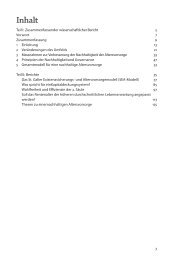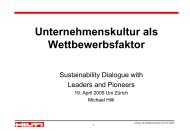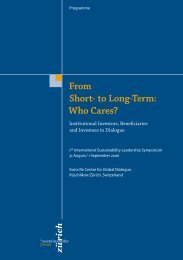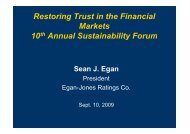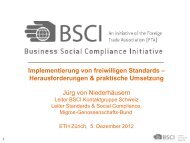Fostering Corporate Responsibility through Self- and Co-regulation
Fostering Corporate Responsibility through Self- and Co-regulation
Fostering Corporate Responsibility through Self- and Co-regulation
Create successful ePaper yourself
Turn your PDF publications into a flip-book with our unique Google optimized e-Paper software.
Sector-specific CR in five industry sectors<br />
Sector-specific CR in five industry sectors<br />
The following table gives an overview of the<br />
state of sector-specific CR in Europe. The information<br />
represents a summary of the results of<br />
an online-survey with national CR experts, a<br />
snap poll with national industry experts <strong>and</strong><br />
telephone interviews with international experts.<br />
This data was complemented by extensive<br />
literature <strong>and</strong> desktop research.<br />
Sector Characteristics Challenges Issues<br />
Chemicals<br />
Share of GVA – 10.7<br />
Share of workforce – 5.4<br />
resource-intensive;<br />
decisive for technological developments;<br />
use of hazardous substances;<br />
affect on environment <strong>and</strong> human well-being;<br />
mostly business-to-business<br />
demographic change;<br />
climate change;<br />
scarcity of natural resources<br />
environmental protection;<br />
health <strong>and</strong> plant/product safety;<br />
labour practices;<br />
corporate governance;<br />
climate protection;<br />
innovation<br />
<strong>Co</strong>nstruction<br />
Share of GVA – 5.6<br />
Share of workforce – 7.1<br />
delivers infrastructure for other sectors;<br />
bulky, expensive, long-lasting <strong>and</strong> often<br />
customer-tailored products;<br />
price competition <strong>and</strong> time pressure;<br />
project-based character;<br />
locally organised <strong>and</strong> SME-dominated;<br />
relevant for public procurement;<br />
long, complex supply chains<br />
scarcity of resources;<br />
financial <strong>and</strong> economic<br />
environment;<br />
association with corruption<br />
health <strong>and</strong> safety;<br />
eco- <strong>and</strong> energy efficiency;<br />
labour practices;<br />
operational <strong>and</strong> business practices<br />
(e.g., anti-corruption)<br />
WRT<br />
Share of GVA – 9.3<br />
Share of workforce – 11.5<br />
wholesale trade<br />
large, low in number <strong>and</strong> capital-intensive<br />
deliveries;<br />
transportation <strong>and</strong> warehousing are essential;<br />
specialisation in one product group;<br />
relevant to public procurement;<br />
retail trade<br />
customer loyalty <strong>and</strong> satisfaction are<br />
essential;<br />
broad spectrum of goods;<br />
SME-dominated;<br />
gatekeeper between producers <strong>and</strong><br />
consumers<br />
climate change;<br />
poverty <strong>and</strong> inequality;<br />
financial <strong>and</strong> economic<br />
environment;<br />
scarcity of natural resources;<br />
competition from emerging markets<br />
energy <strong>and</strong> water use;<br />
packaging <strong>and</strong> waste management;<br />
transport <strong>and</strong> use of sustainable<br />
materials; working conditions<br />
(e.g., wages, gender discrimination);<br />
health <strong>and</strong> safety;<br />
global supply chain;<br />
employee <strong>and</strong> customer relations;<br />
carbon footprint of products<br />
ICT<br />
Share of GVA – 8.0<br />
Share of workforce – 3.3<br />
dynamic, innovative <strong>and</strong> diverse;<br />
second-most-globalised sector;<br />
key factor for growth (e.g., productivity,<br />
innovation <strong>and</strong> efficiency);<br />
convergence of products <strong>and</strong> markets;<br />
relocation of production facilities to lowincome<br />
countries;<br />
division between production <strong>and</strong> services <strong>and</strong><br />
between R&D <strong>and</strong> manufacturing/assembly<br />
financial <strong>and</strong> economic<br />
environment;<br />
resource scarcity;<br />
competition from emerging<br />
economies;<br />
illiteracy<br />
production subsectors<br />
labour conditions;<br />
health <strong>and</strong> safety;<br />
environment<br />
telecommunications<br />
fair operating practices;<br />
e-waste;<br />
job quality (e.g., working<br />
conditions, gender, wages, working<br />
hours, etc.);<br />
consumer relations;<br />
community involvement<br />
Financial services<br />
Share of GVA – 7.5<br />
Share of workforce – 4.6<br />
intermediary function in the economy;<br />
diversity of financial institutions;<br />
differentiation between direct <strong>and</strong> indirect<br />
impact of financial institutions<br />
trust problems;<br />
financial <strong>and</strong> economic environment<br />
customer relations;<br />
employee relations;<br />
community involvement;<br />
environmental issues;<br />
financial inclusion;<br />
fair operating practices<br />
(e.g., anti-corruption);<br />
55




